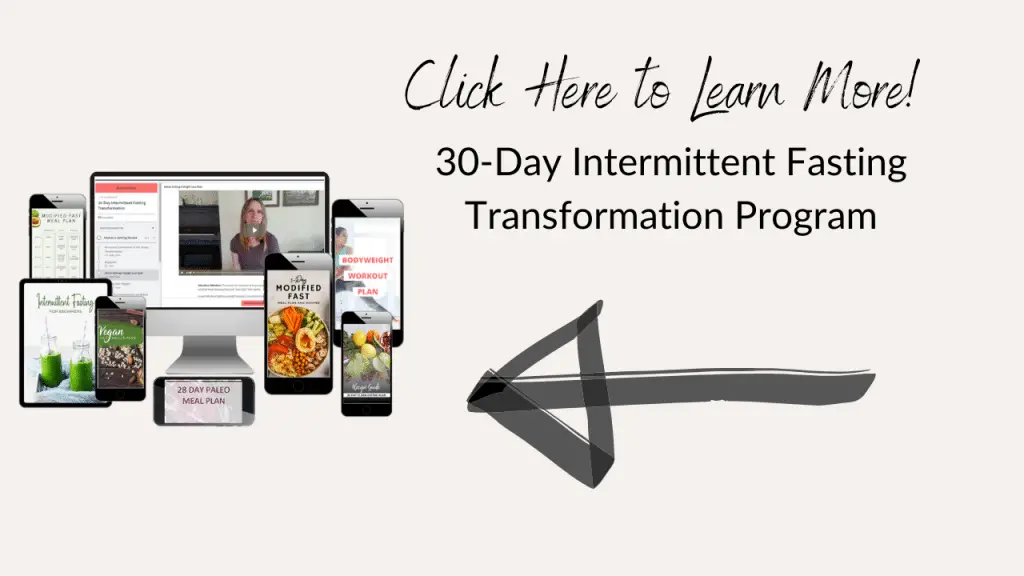Typically, women will need to practice intermittent fasting differently than men to achieve their weight loss goals. However, I wouldn’t say I like it when health experts promote their advice like it’s the only way, so that’s not what I will do here. The intermittent fasting for weight loss for women tips that I will share summarize what I have learned over the last two and a half years of experimenting with fasting. However, if something else works for you and you love it, do you!
Intermittent Fasting for Weight Loss for Women
Notice that the tips in this post relate to intermittent fasting for women AND weight loss. Once you reach your weight loss goal, my advice will differ slightly. We will also talk about that a little bit, so keep reading!

Why Intermittent Fasting Works for Weight Loss for Women Works
Intermittent fasting is not an “extreme diet.” It’s simply a way to naturally restrict your calorie intake while enjoying your favorite foods and restoring your hormonal balance. Many women will find that they can’t seem to lose weight (particularly as they age) because frequent eating has been wrecking their hormones. Their bodies have been producing insulin constantly for years and have become resistant to it. This causes two issues that impede weight loss for women:
- They feel “hungry” all the time: I am sure you have experienced wanting to eat something sweet after a meal and wanting to eat, even though you knew you were not hungry. This makes it really hard to stick to any diet long-term. You have become a slave to food.
- High insulin levels cause fat storage: Insulin is called a fat-storing hormone because it stimulates your muscle, fat, and liver cells to convert the extra energy into fat (particularly around your midline). Plus, the extra food you consume requires your body to produce even more insulin. It’s a vicious cycle.
Intermittent fasting works for weight loss for women because it reduces the need for insulin and resets your hunger hormones.

How to Practice Intermittent Fasting for Weight Loss for Women
In my thirties, I tried intermittent fasting for weight loss, and it didn’t “work” for one simple reason: I wasn’t fasting long enough to become metabolically flexible. This is precisely what this section is about: showing you how to practice intermittent fasting so you can become metabolically flexible for sustainable weight loss.
What It Means to Be Metabolically Flexible
What do I mean by metabolically flexible? Your body learns to use ketones for energy instead of relying on glucose. This ability to quickly switch from glucose to ketones means you gain freedom over food cravings and know the signs of true hunger. Furthermore, guess where ketones come from? Yes, your fat cells! You are burning fat as you teach your body to stop relying on glucose!
How to Become Metabolically Flexible
Becoming metabolically flexible is critical when it comes to intermittent fasting for weight loss for women. That’s why metabolic flexibility is at the core of my 30-Day Intermittent Fasting Transformation.
As you start fasting, you may find it more difficult to fast for extended periods. Be patient with yourself! It will come with practice. Moreover, you can use one of two simple tools to speed up the process: a 5-day modified fast or a 7 to 14-day keto cycle.

Modified Fasting
My favorite way to kick start weight loss is a 5-Day Modified Fast. A 5-Day modified fast is based on the Fasting Mimicking Diet. It’s like pressing the reset button to heal your body. The severe calorie restriction will cause your body to run out of glycogen. Then, you can experiment with intermittent fasting to find your optimal fasting window.
Read Modified Fasting: How You Can Benefit From Fasting Without Starving to learn more about modified fasting.
Learn about my 30-Day Intermittent Fasting Transformation.

Keto Cycle
Your body will run out of glucose and learn to rely on ketones on a modified fast because it severely restricts your calorie intake. Another way to accomplish this is a keto cycle. People usually lose weight on the keto diet because they notice that their appetite decreases. They feel amazing and naturally tend to eat fewer calories. The problem is that most people will not sustain the keto diet long-term. That’s why I like to use the keto diet as a reset tool in the context of intermittent fasting for weight loss. If you don’t think you can manage to go hungry for five days, try a one or two-week keto cycle instead.
I even created a keto menu plan you can use. I don’t want you to be eating keto pizza for two weeks. You need to make sure your keto cycle is as nutrient-dense as possible.

How to Make Sure Your Body Is Producing Enough Ketones
After your first reset, you will likely know what it feels like when your body uses ketones for energy. This “switch” means your body is in fat-burning mode. Here’s how you will feel:
- More energy
- More focus
- Not feeling “hangry” when your stomach is empty
If you would like to look at numbers to confirm what you are feeling, get a ketone monitor. I liked checking my ketones regularly when I was fasting for weight loss, particularly upon waking and when I felt “the switch” (which typically happened around the 1mmol/L mark). This info will also help you set your fasting window once you are ready to experiment with intermittent fasting. If you want a ketone monitor, I recommend the Keto Mojo. Receive a 15% discount with my affiliate link.

How to Pick Your Intermittent Fasting Window
Now that you understand the importance of switching to ketones to become metabolically flexible, you can pick the right intermittent fasting window. Most women will find they thrive using a longer but less frequent fast. I discovered that I had to fast for 16-18 hours to feel “the switch.” I would then want to be in optimal ketosis for 2-4 hours. Consequently, a 20-hour fast five days a week was optimal.
Another option that would work really well for women is a 24-hour fast two or three days a week. Did you know that for healing your body, the optimal length of your fast should be three days? Since our main concern here is weight loss, you don’t need to fast for three days. Remember, you don’t need to fear longer fasts. Your optimal fasting window is the one you can sustain long-term because it makes you feel amazing.
How Much Weight Will You Lose?
When it comes to intermittent fasting for weight loss for women, patience is key. Remember, sustainable weight loss takes time. Moreover, the closer you are to your goal weight, the longer it will take to lose weight. If you have 20 lbs or less to lose, losing 2 lbs a month is a realistic goal. You can expect to lose weight more quickly if you have more weight to lose, but I don’t want you to obsess over the scale. Trust the process, focus on healing your body through fasting, and provide it with nutrient-dense foods during your eating window.

How to Maintain Your Intermittent Fasting Weight Loss
Believe it or not, once you reach your goal weight, you may find it challenging to stop losing weight. At this point, you most likely have been enjoying the health benefits of fasting for over a year. You want to maintain these benefits without losing weight. As a perimenopausal woman, I found that one of the main benefits of a longer fasting window was improved sleep. Once I stopped fasting for a long because I didn’t want to lose more weight, the quality of my sleep deteriorated. I had to experiment with longer but less frequent fasts to still enjoy my sleep while maintaining my weight. I learned that one 24-hour fast once a week was effective.
If you would like me to take you from wondering how you can stop gaining weight to figuring out how to stop losing weight, don’t forget to check out my 30-Day Intermittent Fasting Transformation. It’s your ultimate weight loss success formula, and it includes everything women need to practice intermittent fasting for weight loss.

Intermittent Fasting for Weight Loss for Women Summary
In summary, intermittent fasting for women’s weight loss is about becoming metabolically flexible. The right intermittent fasting method for you is the one that will teach your body to stop relying on glucose for energy. Once you can do that, you have found food freedom and are on the path to learning your true hunger cues. Congratulations!



